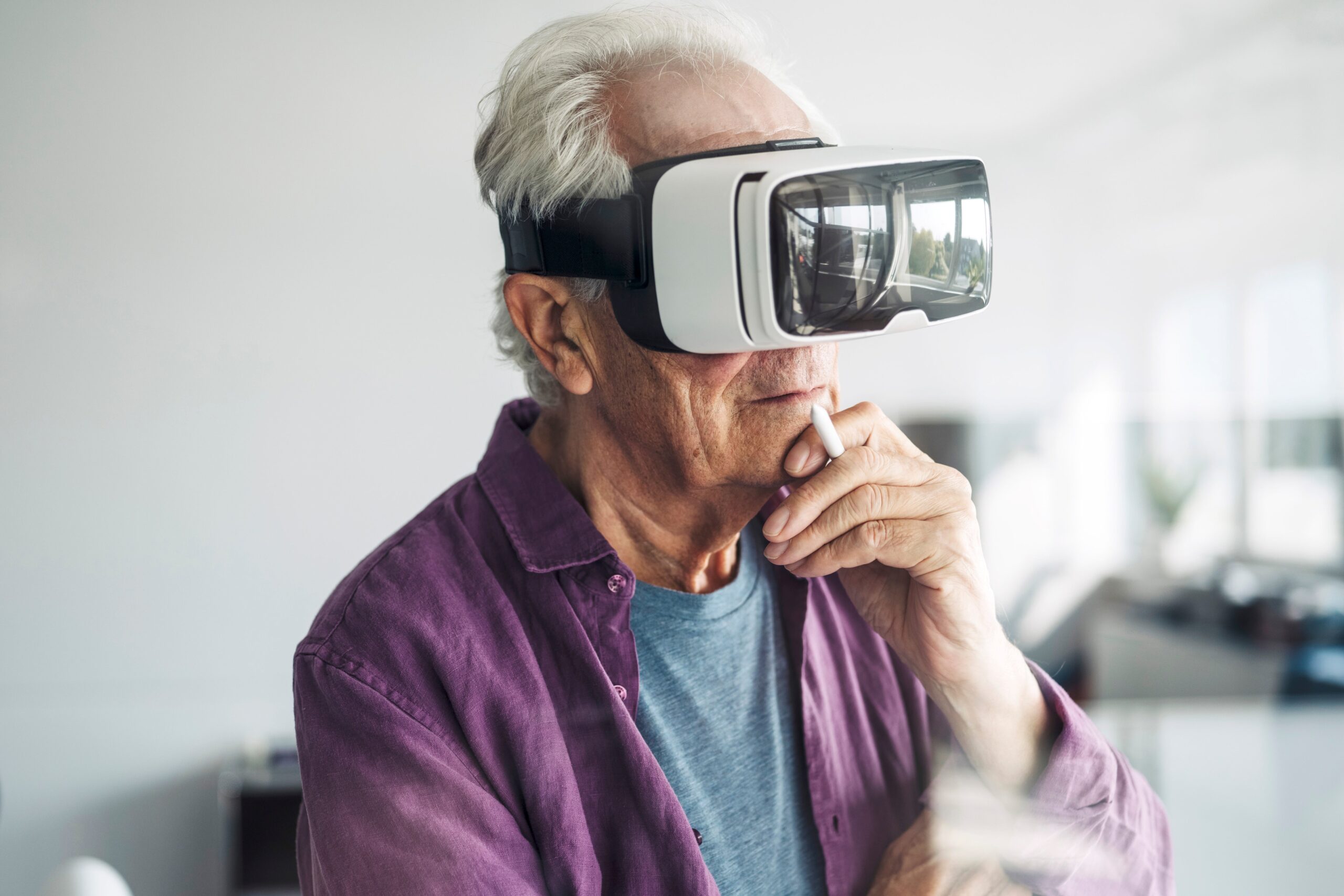Table of Contents
- A Brief History of VR and AR Controllers
- The Evolution of VR and AR Controllers
- Motion Tracking
- Haptic Feedback
- Finger Tracking
- Integration with Gesture Recognition
- Spatial Audio Integration
- Applications Across Industries
- Education
- Healthcare
- Architecture and Design
- Military and Defense
- The Future of VR and AR Controllers
In the realm of technology and immersive experiences, the emergence of Virtual Reality (VR) and Augmented Reality (AR) has reshaped our understanding of how we interact with digital environments. A crucial element that has driven the evolution of these immersive technologies is the development of VR and AR controllers. These controllers have played a pivotal role in enhancing the precision, interactivity, and overall immersion within virtual and augmented worlds. In this article, we delve into the fascinating rise of VR and AR controllers, exploring their evolution, capabilities, and the impact they have on our digital lives.
The advent of Virtual Reality (VR) and Augmented Reality (AR) represents a watershed moment in the evolution of technology and immersive experiences. It’s a transformation that has redefined not only how we interact with digital environments but also how we perceive and engage with the world around us. At the heart of this evolution lies the remarkable development of VR and AR controllers – devices that are central to elevating the precision, interactivity, and overall immersion within these virtual and augmented realms. In this article, we embark on a journey through the fascinating rise of VR and AR controllers, shedding light on their evolution, capabilities, and the profound impact they exert on our digital lives.
The Genesis of VR and AR Controllers: The origins of VR and AR controllers can be traced back to early experiments in the 1960s and 1970s, where rudimentary interfaces were employed to interact with digital simulations. However, it was not until recent decades that these controllers underwent a remarkable transformation. The introduction of devices like the Nintendo Power Glove in the late 1980s laid the foundation for gesture-based control in VR and AR. Still, it wasn’t until the 2010s that we witnessed a true renaissance in controller design.
From Wii Remotes to Oculus Touch: The Nintendo Wii’s motion controllers, the Wii Remote and Nunchuk, were pioneering in their use of motion-sensing technology. They allowed players to physically engage with games, swinging a virtual tennis racket or casting spells with a flick of the wrist. This marked a turning point in gaming, ushering in an era of more immersive and physically interactive gameplay.
However, it was the arrival of Oculus Touch controllers that truly revolutionized VR interactions. Released in 2016 alongside the Oculus Rift headset, these handheld controllers introduced precise hand-tracking, haptic feedback, and intuitive finger gestures. Users could now reach out and grab objects, point, and make natural hand movements within the virtual environment, significantly enhancing immersion.
Gesture Recognition and Natural Interaction: Gesture recognition has played a pivotal role in making VR and AR more intuitive and user-friendly. Controllers equipped with sensors and cameras can track hand and finger movements with remarkable precision, allowing users to interact with virtual objects and environments in a way that feels natural and immersive.
Haptic Feedback for Sensory Realism: Haptic feedback technology integrated into these controllers further amplifies the sensory experience. Users can feel vibrations, resistance, and even tactile sensations that mimic the physical world. This adds an extra layer of realism and engagement, whether it’s feeling the recoil of a virtual gun or the texture of a virtual object.
Multi-Modal Control: VR and AR controllers are becoming increasingly versatile, incorporating multiple input methods. This includes not only hand tracking but also voice recognition, eye tracking, and even brain-computer interfaces. These multi-modal controls enhance accessibility and provide a more holistic and nuanced way to interact with digital environments.
Impact on Industries: Beyond gaming and entertainment, VR and AR controllers are making significant inroads into industries such as education, healthcare, architecture, and training. They are empowering professionals to manipulate complex data, conduct remote surgeries, or train in realistic simulations, ultimately revolutionizing the way we work and learn.
Future Frontiers: As technology continues to advance, VR and AR controllers are poised to become even more sophisticated. We can anticipate improvements in battery life, form factor, and integration with wearable devices like AR glasses. Additionally, the integration of AI and machine learning will enable controllers to adapt to user preferences and offer highly personalized and context-aware interactions.
In conclusion, VR and AR controllers have transformed how we interact with digital environments, bridging the gap between the physical and digital realms. Their evolution represents a powerful convergence of technology and human experience, offering tantalizing possibilities for the future, where the boundaries between reality and the virtual world continue to blur, and our digital lives become ever more immersive and engaging.
To expand your knowledge on this subject, make sure to read on at this location: Metaverse beyond the hype: Multidisciplinary perspectives on …
A Brief History of VR and AR Controllers
The concept of VR and AR controllers can be traced back to the early days of virtual reality, which dates back to the 1960s and 1970s. However, it wasn’t until recent years that these controllers became a standard component of immersive experiences. Early VR systems relied on crude interfaces, such as data gloves and rudimentary motion-sensing devices, to interact with digital environments. These devices were often clunky, imprecise, and limited in functionality.
The breakthrough moment came with the introduction of consumer-grade VR headsets like the Oculus Rift and HTC Vive in the mid-2010s. These headsets included hand-held controllers that allowed users to see and interact with their hands in the virtual world. This marked a significant leap in immersion and user engagement.
To expand your knowledge on this subject, make sure to read on at this location: Metaverse beyond the hype: Multidisciplinary perspectives on …

The Evolution of VR and AR Controllers
Over the years, VR and AR controllers have evolved rapidly, incorporating cutting-edge technology to enhance their precision and functionality. Here are some key developments in their evolution:
The evolution of VR (Virtual Reality) and AR (Augmented Reality) controllers has been nothing short of remarkable, driven by advancements in technology and a relentless pursuit of enhancing user experiences. Here are some notable developments in their evolution:
Improved Tracking Technology: Early VR controllers often relied on basic tracking methods, such as gyroscopes and accelerometers. However, the introduction of external tracking systems like the Oculus Constellation and Valve’s Lighthouse dramatically improved controller accuracy. Inside-out tracking, where sensors are integrated directly into the controllers, further simplified setup and expanded the range of motion.
Hand and Finger Tracking: The quest for more natural interactions led to the development of controllers that can track not just the position but also the movement of individual fingers. This technology allows users to make gestures and manipulate objects in VR/AR environments with incredible precision, enhancing immersion and realism.
Haptic Feedback: Haptic feedback technology has been integrated into controllers to provide tactile sensations, making virtual interactions feel more lifelike. Users can now feel vibrations, resistance, and even simulated textures when interacting with objects in VR/AR, greatly enhancing the sense of presence.
Gesture Recognition: Some controllers now incorporate gesture recognition technology, enabling users to control actions and interactions through hand gestures rather than physical buttons. This intuitive approach simplifies navigation and interaction in immersive environments.
Mixed Reality Integration: AR controllers have evolved to seamlessly blend digital and physical worlds. These controllers enable users to interact with both virtual and real objects simultaneously, opening up a wide range of possibilities for gaming, education, training, and more.
Adaptive Ergonomics: Manufacturers have placed a strong emphasis on ergonomics to ensure that controllers are comfortable for extended use. Customizable grips, button layouts, and adjustable straps cater to a wide range of hand sizes and preferences.
Wireless Connectivity: Wireless controllers have become the norm, eliminating the need for cumbersome cables and improving freedom of movement. Bluetooth and other wireless technologies have made it possible for users to enjoy VR/AR experiences without being tethered to a computer or console.
Integration with Biometrics: Some controllers incorporate biometric sensors to monitor physiological responses such as heart rate and skin conductance. This data can be used to enhance gameplay experiences and provide valuable insights for applications like health and wellness.
Integration of Spatial Audio: Advanced controllers now incorporate spatial audio technology to provide users with immersive 3D sound. This enhances the sense of presence and spatial awareness, making virtual environments feel more realistic.
Cross-Platform Compatibility: Interoperability has improved significantly, allowing users to use their VR/AR controllers across different platforms and ecosystems. This has helped standardize the user experience and expand the user base.
Developer Accessibility: Manufacturers are actively working to make their hardware more accessible to developers. Software development kits (SDKs) and APIs provide developers with the tools they need to create innovative applications and experiences using VR/AR controllers.
Cost Reduction: As technology matures, costs have come down, making VR/AR controllers more accessible to a wider audience. This affordability has driven adoption across various industries, including gaming, education, healthcare, and design.
The rapid evolution of VR and AR controllers is a testament to the ever-expanding possibilities of immersive technology. These advancements continue to redefine the way we interact with virtual and augmented environments, making them not just tools for entertainment but powerful tools for education, training, simulation, and real-world applications. As technology continues to progress, we can expect even more exciting developments in the future of VR and AR controllers.
Looking for more insights? You’ll find them right here in our extended coverage: Metaverse beyond the hype: Multidisciplinary perspectives on …

Motion Tracking
Modern VR and AR controllers employ advanced motion-tracking technology, such as infrared sensors and accelerometers, to precisely capture the user’s hand movements. This ensures that your virtual hand movements closely mirror your real-world actions, creating a seamless and immersive experience.
The advent of modern Virtual Reality (VR) and Augmented Reality (AR) controllers has ushered in a new era of immersive and interactive experiences. These controllers, equipped with state-of-the-art motion-tracking technology, represent a significant leap forward in blurring the lines between the physical and digital worlds.
At the heart of these controllers lie advanced motion-tracking sensors, such as infrared sensors and accelerometers, that function as the eyes and ears of your virtual presence. These sensors work in harmony to precisely capture and interpret the movements of your hands, translating them into actions and interactions within the virtual environment. This level of precision is nothing short of remarkable, as it ensures that your virtual hand movements closely mirror your real-world actions.
In the realm of VR, this technology is particularly transformative. When you reach out to grasp a virtual object, the controller tracks your hand’s position and orientation with remarkable accuracy. As you manipulate and interact with objects in the virtual world, the controller’s sensors capture even subtle nuances of movement, providing a level of responsiveness that makes you feel truly present within the digital realm. Whether you’re wielding a virtual sword, painting a masterpiece, or solving complex puzzles, the sensation of your actions seamlessly translating into the virtual world is awe-inspiring.
AR controllers, on the other hand, overlay digital information onto the physical world, enhancing our perception of reality. These controllers utilize motion tracking to precisely align digital objects with your real-world surroundings. This synchronization ensures that digital elements seamlessly blend into your environment, whether you’re exploring educational AR simulations, navigating augmented cityscapes, or playing immersive AR games. The controllers enable you to interact with these digital overlays as if they were tangible objects in your physical space, opening up a world of creative and practical possibilities.
Beyond gaming and entertainment, these advanced controllers have found applications in education, healthcare, training, and various industries. They enable surgeons to practice delicate procedures in a risk-free virtual environment, allow architects to visualize and manipulate 3D building designs, and offer students immersive learning experiences that transcend traditional textbooks.
In summary, modern VR and AR controllers, armed with sophisticated motion-tracking technology, have redefined the boundaries of human-computer interaction. They have propelled us into a new era where the virtual and real worlds seamlessly converge, offering unparalleled levels of immersion and interactivity. As these technologies continue to evolve, the possibilities for innovative, practical, and transformative applications are boundless, promising a future where our digital and physical realities are more intertwined than ever before.
You can also read more about this here: Review Virtual and augmented reality for biomedical applications

Haptic Feedback
Haptic feedback has become a game-changer in the world of VR and AR controllers. These controllers are equipped with vibrating motors and force feedback mechanisms, allowing users to feel a sense of touch and interaction with virtual objects. When you pick up a virtual object or touch a surface, the controller provides realistic tactile feedback, enhancing the sense of presence.
The integration of haptic feedback into VR (Virtual Reality) and AR (Augmented Reality) controllers marks a significant milestone in immersive technology. These controllers, equipped with vibrating motors and advanced force feedback mechanisms, have introduced a new dimension of sensory engagement, revolutionizing the way users interact with virtual environments and objects.
The primary benefit of haptic feedback is the heightened sense of immersion it offers. In traditional VR and AR experiences, visual and auditory cues dominate the sensory input, leaving touch and physical feedback relatively limited. Haptic feedback bridges this sensory gap by allowing users to feel the virtual world physically. When you reach out to grab an object in a virtual space, the controller responds with vibrations and force feedback that mimic the sensation of touch. This tangible connection with the virtual environment enhances the overall sense of presence, making users feel as if they are truly interacting with their surroundings.
Haptic feedback also contributes to a more intuitive and realistic interaction with virtual objects. Users can gauge the texture, weight, and physical properties of virtual items through the sensations transmitted by the controller. This tactile feedback not only adds depth to the experience but also enables users to manipulate objects with precision and confidence. Tasks such as picking up delicate objects or feeling the resistance of a virtual button become more natural and intuitive, enhancing the user’s sense of control.
Moreover, haptic feedback has wide-ranging applications across various industries. In gaming, for instance, it elevates the gameplay experience by providing players with a deeper connection to the in-game world. Imagine feeling the recoil of a virtual firearm or the rumble of a vehicle’s engine as you race through a digital landscape. These sensations not only add excitement but also convey important gameplay information.
Outside of gaming, haptic feedback has practical implications in fields like education and training. Simulated environments can replicate real-world scenarios, allowing learners to practice tasks that require physical dexterity and sensory perception. Surgeons can practice surgical procedures, mechanics can fine-tune their skills, and pilots can undergo flight training—all with the benefit of realistic haptic feedback.
Furthermore, as haptic technology continues to advance, the possibilities for enhancing user experiences are boundless. Developers are exploring the integration of more nuanced sensations, such as temperature and pressure, into haptic feedback systems, further blurring the line between the physical and virtual worlds.
In conclusion, haptic feedback has emerged as a game-changer in the realm of VR and AR technology. Its ability to provide users with realistic tactile sensations not only enhances immersion but also unlocks new possibilities for training, education, and entertainment. As haptic feedback technology evolves, it is poised to play an increasingly central role in shaping the future of immersive experiences, bringing the virtual world closer to reality than ever before.
To delve further into this matter, we encourage you to check out the additional resources provided here: A systematic review of immersive virtual reality applications for …

Finger Tracking
Some controllers, like the Oculus Quest hand tracking feature, have introduced finger tracking technology. This innovation enables users to control virtual objects with individual finger movements, further bridging the gap between the physical and virtual worlds.
Some controllers, like the Oculus Quest hand tracking feature, have introduced finger tracking technology, representing a remarkable leap in the evolution of virtual reality (VR) interfaces. This innovation goes beyond traditional controller inputs, enabling users to control virtual objects with individual finger movements, and it carries profound implications for the immersive experiences of the future.
Natural Interaction: Finger tracking technology mimics the way we interact with the real world. It eliminates the need for controllers and buttons, allowing users to directly manipulate virtual objects with their hands. This natural interaction enhances immersion and makes VR more accessible to newcomers.
Gesture Recognition: Finger tracking can recognize a wide range of gestures, from simple pointing to complex hand movements. This opens the door to intuitive and expressive communication within virtual environments. Gamers can wave, give thumbs up, or even perform intricate gestures, adding depth to multiplayer interactions and gameplay.
Fine Motor Control: The precision of finger tracking is unparalleled. Users can pick up and manipulate small objects with dexterity, enhancing the realism of VR experiences. This level of fine motor control is invaluable in applications beyond gaming, such as virtual training and simulations for professionals.
Enhanced Immersion: The ability to use your fingers as controllers brings a new level of immersion to VR. Tasks that were once cumbersome with traditional controllers, like typing on a virtual keyboard or playing a virtual musical instrument, become intuitive and engaging with finger tracking technology.
Accessibility: Finger tracking technology has the potential to improve accessibility in VR. Users with physical disabilities may find it easier to navigate virtual environments and engage in VR experiences without the need for complex button inputs or controllers.
Creative Expression: Beyond gaming and practical applications, finger tracking technology unlocks new avenues for creative expression. Artists can paint, sculpt, and create in three-dimensional virtual spaces using their hands as tools, expanding the possibilities of digital art.
Gesture-Based Learning: In educational VR applications, finger tracking can facilitate gesture-based learning. Students can interact with virtual models, conduct virtual experiments, and engage in hands-on learning experiences that closely mimic real-world scenarios.
Healthcare and Rehabilitation: Finger tracking has potential applications in healthcare and rehabilitation. It can be used in physical therapy exercises and rehabilitation programs, providing patients with interactive and engaging activities to aid their recovery.
Continuous Advancements: As technology evolves, we can anticipate further refinements in finger tracking technology. More sophisticated sensors, enhanced gesture recognition algorithms, and increased compatibility with various VR platforms will continue to push the boundaries of what’s possible in the virtual realm.
In summary, finger tracking technology is a game-changer in the world of virtual reality. It bridges the gap between the physical and virtual worlds, offering natural interaction, precision, and a wealth of creative and practical possibilities. As this technology continues to develop, it will shape the future of immersive experiences, from gaming and entertainment to education, healthcare, and beyond.
If you’d like to dive deeper into this subject, there’s more to discover on this page: The rise of artificial intelligence in healthcare applications – PMC

Integration with Gesture Recognition
Gesture recognition technology is another exciting development in the realm of VR and AR controllers. It enables users to perform complex actions in virtual environments simply by making hand gestures. This eliminates the need for traditional button-based inputs and enhances the sense of immersion.
Gesture recognition technology is another exciting development in the realm of VR and AR controllers. It enables users to perform complex actions in virtual environments simply by making hand gestures. This eliminates the need for traditional button-based inputs and enhances the sense of immersion.
The adoption of gesture recognition in VR and AR controllers represents a significant leap forward in user interaction. It offers a more intuitive and natural way to navigate and interact within virtual worlds. With this technology, users can convey their intentions with a simple wave, point, or grasp, mimicking how they would interact with objects and spaces in the real world.
One of the most compelling aspects of gesture recognition is its potential to bridge the gap between the digital and physical realms. By allowing users to use their hands and body movements as controllers, it brings a sense of direct interaction with virtual objects. For instance, in a VR cooking simulation, you can pick up a virtual knife and chop vegetables with the same fluidity and precision as in the real world, all thanks to gesture recognition.
Moreover, this technology enhances accessibility and inclusivity in the world of immersive experiences. It reduces the learning curve for newcomers to VR and AR, making these technologies more accessible to people of all ages and backgrounds. For those with physical disabilities or limited dexterity, gesture recognition offers a more viable means of interaction than traditional controllers.
As gesture recognition technology continues to evolve, we can expect it to become even more precise and versatile. Advanced sensors and machine learning algorithms will enable systems to recognize an extensive range of gestures, from intricate hand movements to full-body actions. This will open up a world of creative possibilities for game developers and designers, allowing for deeper and more engaging experiences.
Furthermore, the integration of biometric data into gesture recognition could take immersion to the next level. Imagine VR experiences that respond not only to your hand movements but also to your emotions, providing more nuanced interactions and reactions within the virtual environment.
In conclusion, gesture recognition technology is revolutionizing the way we interact with virtual and augmented reality environments. By making interactions more natural and intuitive, it enhances immersion, accessibility, and inclusivity in these digital realms. As this technology continues to evolve, it holds the promise of unlocking new dimensions of creativity and personalization, bringing us closer to truly lifelike and captivating virtual experiences.
Should you desire more in-depth information, it’s available for your perusal on this page: Metaverse beyond the hype: Multidisciplinary perspectives on …

Spatial Audio Integration
Modern controllers often include integrated spatial audio technology, allowing users to hear sound from different directions, adding another layer of realism to the virtual experience.
Modern controllers have undergone a remarkable transformation, embracing integrated spatial audio technology as a game-changer in the quest for heightened realism in the virtual world. This innovation doesn’t just add another layer of realism; it fundamentally reshapes how players perceive and engage with their digital environments.
Immersive Soundscapes: Integrated spatial audio technology transports players to the heart of the action. It enables precise sound localization, so whether it’s footsteps echoing behind, a distant explosion, or the rustle of leaves in a virtual forest, players experience sound as if it were originating from the exact location it should within the game.
Enhanced Gameplay: Spatial audio isn’t just about immersion; it’s a gameplay enhancer. It equips players with a tactical advantage by providing audible cues about in-game events and the whereabouts of opponents. This heightened awareness can be the difference between victory and defeat in competitive gaming.
Adaptive Audio: Modern controllers are incorporating adaptive audio that responds to in-game situations. For instance, as a character moves through a cave, the audio adjusts to simulate the echo and reverberation of that environment. This adaptability adds depth and richness to the gaming experience.
Personalized Soundscapes: Spatial audio technology doesn’t treat all players the same. It’s highly adaptable and can be personalized to suit individual preferences. Players can fine-tune their audio settings to amplify specific sound elements, enhancing their gaming experience according to their unique style and needs.
Cross-Platform Compatibility: As gaming ecosystems become more interconnected, spatial audio technology is designed with cross-platform compatibility in mind. Whether you’re gaming on a console, PC, or mobile device, you can expect a consistent and immersive audio experience.
Accessibility: Spatial audio technology contributes to greater accessibility in gaming. It offers crucial audio cues for players with visual impairments and creates a more inclusive gaming environment. This aligns with the broader trend of making gaming accessible to players of all abilities.
Narrative Enhancement: Spatial audio isn’t limited to gameplay; it elevates storytelling. In narrative-driven games, it adds emotional depth by enveloping players in the environment and making them feel like active participants in the unfolding story.
Future Potential: As technology advances, spatial audio’s potential is boundless. With the integration of AI and machine learning, it can adapt in real-time to a player’s behavior, creating personalized soundscapes that react to their actions and emotions, further blurring the lines between reality and the virtual world.
In conclusion, integrated spatial audio technology in modern controllers is a game-changer in the quest for immersive gaming experiences. It transforms how players perceive and interact with virtual environments, adding realism, tactical advantages, and personalization. As gaming technology continues to evolve, spatial audio will play an increasingly integral role, enriching the sensory dimension of gaming and pushing the boundaries of what’s possible in the virtual realm.
For a comprehensive look at this subject, we invite you to read more on this dedicated page: Current and Potential Uses of AR/VR for Equity and Inclusion | ITIF

Applications Across Industries
The rise of VR and AR controllers has not been limited to the gaming industry. These controllers have found applications across a wide range of industries:
The rise of VR (Virtual Reality) and AR (Augmented Reality) controllers has not been limited to the gaming industry. These versatile controllers have found applications across a wide range of industries, ushering in a new era of innovation and transformation.
Education: In the realm of education, VR and AR controllers have revolutionized the learning experience. Students can now interact with three-dimensional models, explore historical sites virtually, and conduct virtual science experiments. These controllers enable a more immersive and engaging approach to education, making complex subjects more accessible and enjoyable.
Healthcare: Medical professionals are using VR and AR controllers for simulations, training, and surgical planning. Surgeons can practice intricate procedures in a risk-free virtual environment, enhancing their skills and reducing the chances of errors during actual surgeries. Additionally, VR therapies are being employed for pain management and rehabilitation.
Architecture and Design: Architects and designers are using VR controllers to create and manipulate virtual prototypes of buildings and products. This allows for real-time design adjustments and collaborative decision-making, ultimately leading to more efficient and innovative design processes.
Manufacturing: VR and AR controllers have found applications in manufacturing and assembly processes. Workers can receive step-by-step visual instructions overlaid onto their field of view, reducing errors and improving efficiency. These controllers also facilitate remote maintenance and troubleshooting.
Aerospace: In aerospace, VR controllers aid in the design and testing of aircraft and spacecraft. Engineers can visualize and simulate complex systems, ensuring safety and reliability in aerospace technology.
Entertainment: Beyond gaming, VR controllers are enhancing the entertainment industry. They enable immersive experiences in virtual concerts, theme park attractions, and cinematic storytelling, providing audiences with entirely new forms of entertainment.
Training and Simulation: Military and law enforcement agencies use VR and AR controllers for training simulations, helping personnel prepare for real-world scenarios in a safe and controlled environment.
Retail: In retail, AR controllers are being used to create interactive shopping experiences. Customers can visualize products in their own space before making a purchase decision, enhancing the online shopping experience.
Tourism: AR controllers enhance tourism by offering guided virtual tours with augmented information and historical context at various landmarks and destinations.
Sports: Athletes and coaches use VR controllers for performance analysis and training. They can review and dissect plays in a 3D virtual environment to improve strategies and skills.
In summary, VR and AR controllers have transcended their initial gaming applications and are now driving innovation and efficiency across multiple industries. Their ability to create immersive and interactive experiences is reshaping how we learn, work, and engage with the world around us, promising exciting possibilities for the future.
For a comprehensive look at this subject, we invite you to read more on this dedicated page: The rise of artificial intelligence in healthcare applications – PMC

Education
VR controllers have revolutionized education by enabling immersive learning experiences. Students can interact with historical artifacts, explore the human body, or conduct virtual science experiments, all while using VR controllers to manipulate objects and environments.
VR controllers have indeed sparked an educational revolution by fundamentally transforming the way students learn and engage with their subjects. These controllers have not merely enhanced the learning process but have opened up a world of possibilities that were previously unimaginable.
One remarkable aspect of VR controllers in education is their ability to transport students to different time periods and locations, thereby providing a hands-on historical experience. Imagine a history class where students can pick up and examine ancient artifacts with their own hands, gaining an intimate understanding of the past. Instead of reading about Egyptian mummies or ancient Greek pottery, they can virtually hold these objects, turning the pages of history in a profoundly immersive way.
Furthermore, the study of human anatomy has been greatly enriched by VR controllers. Students can take a virtual journey inside the human body, exploring organs, tissues, and biological systems with an unparalleled level of detail. By manipulating virtual anatomical structures using the controllers, learners gain a tactile understanding of the complexities of the human form, making medical and biology education far more engaging and accessible.
VR controllers have also revolutionized science education. They allow students to conduct virtual experiments in a risk-free environment, fostering experimentation and exploration without the constraints of physical resources. Chemistry, physics, and biology experiments can be simulated with utmost precision, enabling students to grasp scientific concepts by actively participating in the scientific process. This hands-on approach not only bolsters comprehension but also instills a sense of curiosity and confidence in young learners.
Moreover, the benefits of VR controllers extend beyond traditional classroom settings. Remote and online learning have become increasingly prevalent, especially in recent times, and VR controllers are playing a pivotal role in bridging the gap between physical and virtual classrooms. Students from around the world can connect in a shared virtual space, interact with each other and the environment, and collaborate on projects and experiments as if they were in the same room. This has the potential to create a more inclusive and globally connected educational landscape.
In conclusion, VR controllers have ushered in a new era of education, one where learning is not confined to textbooks and lectures but extends into immersive, interactive virtual worlds. Students can touch history, explore the inner workings of the human body, and conduct experiments like never before. This technology transcends boundaries, making education accessible and engaging for learners of all ages and backgrounds. As VR and AR continue to evolve, the future of education promises to be an exciting blend of the physical and the virtual, where knowledge knows no bounds.
Don’t stop here; you can continue your exploration by following this link for more details: Authenticity, Interactivity, and Collaboration in Virtual Reality Games …

Healthcare
In healthcare, AR controllers have been used for surgical training, allowing medical professionals to practice procedures in a risk-free virtual environment. VR controllers have also been employed in pain management and therapy.
In healthcare, AR (Augmented Reality) controllers have ushered in a new era of training and education for medical professionals. These controllers provide a powerful tool for surgical training, enabling medical students, residents, and even experienced surgeons to practice complex procedures in a risk-free virtual environment. This immersive training not only enhances their skills but also reduces the potential for errors during real surgeries, ultimately improving patient outcomes.
Moreover, the use of AR controllers extends beyond surgical training. They are employed in medical education, where students can interact with 3D anatomical models, enhancing their understanding of complex structures and diseases. This hands-on, visual approach to learning fosters a deeper comprehension of medical concepts.
On the other hand, VR (Virtual Reality) controllers have found applications in pain management and therapy. VR therapy leverages the immersive capabilities of VR controllers to create soothing and engaging virtual environments. Patients undergoing painful or anxiety-inducing procedures, such as wound dressing changes or physical therapy, can escape into these virtual worlds, effectively distracting them from discomfort and stress.
Additionally, VR controllers are utilized in exposure therapy for patients with phobias or post-traumatic stress disorder (PTSD). By gradually exposing individuals to their fears or traumatic memories in a controlled virtual setting, therapists can help patients desensitize and cope with their anxieties.
The future of AR and VR controllers in healthcare holds even more potential. With ongoing advancements in technology, these controllers are likely to play an increasingly integral role in medical education, patient care, and therapy. From refining surgical techniques to enhancing the quality of life for patients, these immersive technologies are shaping a more effective and empathetic healthcare landscape. As they continue to evolve, we can expect to see even more innovative and impactful applications in the field of medicine.
Explore this link for a more extensive examination of the topic: Metaverse beyond the hype: Multidisciplinary perspectives on …

Architecture and Design
Architects and designers use VR controllers to navigate and modify virtual building models, making it easier to visualize and refine designs.
Architects and designers have embraced the transformative power of VR controllers to revolutionize their creative processes. These versatile tools have become essential instruments in the pursuit of architectural and design excellence, offering a multitude of benefits that extend beyond the realm of traditional drafting and modeling.
One of the most remarkable advantages of VR controllers is their ability to transport architects and designers into the heart of their creations. With the simple press of a button, they find themselves immersed in a three-dimensional digital realm, where they can walk through, explore, and interact with their designs on an entirely new level. This unprecedented level of immersion transcends the limitations of traditional 2D blueprints and computer screens, allowing for a holistic understanding of spatial relationships, scale, and proportions.
Moreover, VR controllers empower architects and designers to become active participants in the design process. They can manipulate elements within the virtual environment with ease, effortlessly resizing, reshaping, or repositioning components as they see fit. This dynamic interactivity fosters creativity, enabling designers to experiment freely, refine concepts on the fly, and explore alternative design solutions.
Collaboration also flourishes in this virtual landscape. Architects and designers can connect with colleagues and clients worldwide, inviting them to join in the immersive design experience. Real-time collaboration not only breaks down geographical barriers but also fosters a deeper understanding among stakeholders, as everyone shares a common spatial perspective. This collaborative synergy leads to more informed decisions and a shared vision for the project.
Furthermore, the benefits extend to the presentation of designs. Architects and designers can create immersive walkthroughs and virtual tours that provide clients and stakeholders with a realistic preview of the final result. This engaging and interactive approach enhances communication and comprehension, allowing for constructive feedback and informed decision-making.
As architects and designers increasingly embrace VR controllers as indispensable tools, they are redefining the boundaries of their professions. These controllers empower them to transcend the limitations of traditional design methodologies, opening up new frontiers of creativity, collaboration, and client engagement. The marriage of technology and design is propelling the fields of architecture and design into an era of limitless possibilities, where imagination knows no bounds, and innovation flourishes.
You can also read more about this here: A systematic review of immersive virtual reality applications for …

Military and Defense
The military uses VR and AR controllers for training simulations, allowing soldiers to practice tactics and operations in realistic virtual environments.
The adoption of Virtual Reality (VR) and Augmented Reality (AR) controllers in military training simulations represents a profound leap forward in preparing soldiers for the complexities of modern warfare. These advanced technologies immerse military personnel in highly realistic virtual environments, providing an unparalleled training experience.
Within these digital realms, soldiers can hone their tactical skills, practice mission-critical operations, and develop teamwork and decision-making abilities under simulated battlefield conditions. VR and AR controllers enable them to interact with these virtual scenarios with a level of immersion that was previously unattainable.
One of the remarkable advantages of these technologies is the ability to recreate diverse combat scenarios, from urban warfare to remote terrains, in a safe and controlled environment. Soldiers can experiment with various strategies, test their adaptability, and learn from their mistakes without real-world consequences. This iterative learning process is invaluable in refining their skills and ensuring they are well-prepared for the ever-evolving challenges of the modern battlefield.
Moreover, the use of VR and AR controllers in military training not only enhances individual soldier readiness but also fosters effective teamwork and coordination. Soldiers can train together, even when geographically dispersed, fostering a sense of camaraderie and a shared understanding of mission objectives.
In essence, the integration of VR and AR controllers into military training represents a visionary approach to preparing troops for the dynamic and unpredictable nature of contemporary warfare. It’s a testament to the military’s commitment to harnessing cutting-edge technology to ensure the safety and effectiveness of its personnel in the face of evolving threats.
To expand your knowledge on this subject, make sure to read on at this location: Virtual Reality Defined & Use Cases | 3D Cloud by Marxent

The Future of VR and AR Controllers
As technology continues to advance, the future of VR and AR controllers looks promising. We can expect to see further refinements in motion tracking, haptic feedback, and gesture recognition. Additionally, the integration of AI and machine learning will likely lead to controllers that can adapt to user preferences and provide more natural interactions.
Furthermore, as VR and AR continue to merge with other emerging technologies like 5G, cloud computing, and the Metaverse, the role of controllers in shaping our digital experiences will only become more significant.
Expanding on the future of VR and AR controllers:
Enhanced Immersion: With ongoing advancements, VR and AR controllers are poised to deliver even more immersive experiences. Improved motion tracking will enable precise and realistic hand and body movements, making users feel truly present in virtual environments.
Sensory Feedback: Haptic feedback technology is evolving rapidly. Future controllers may provide more nuanced and realistic tactile sensations, allowing users to feel everything from the texture of objects to subtle vibrations, adding a deeper layer of immersion to their experiences.
Gesture Recognition: Gesture recognition capabilities will likely become more intuitive and responsive. This means users can interact with virtual objects and environments more naturally, using gestures and hand movements that closely mimic real-world actions.
Adaptive Controllers: AI and machine learning will play a pivotal role in shaping the future of VR and AR controllers. These technologies can analyze user behavior and preferences, adapting controller settings and interactions in real time to provide a highly personalized and enjoyable experience.
Seamless Integration: As VR and AR technologies converge with other emerging tech, such as 5G connectivity and cloud computing, the possibilities for controller functionality expand. Users may access vast, cloud-hosted content libraries instantly, and interactions can occur with minimal latency, enhancing the overall experience.
Collaborative and Social Experiences: Future controllers may facilitate more natural and collaborative interactions in virtual spaces. Users could engage in teamwork, communication, and social activities with greater ease, fostering a sense of presence and connection.
Cross-Platform Compatibility: As VR and AR ecosystems continue to grow, cross-platform compatibility will become increasingly important. Controllers that work seamlessly across different devices and platforms will enhance accessibility and user adoption.
Health and Well-being Features: Future controllers may incorporate health-monitoring features, such as biometric sensors, to track users’ physical well-being during extended VR or AR sessions. These controllers could provide alerts and recommendations to promote a healthy balance between virtual and real-life activities.
Education and Training: VR and AR controllers will continue to revolutionize education and training. They can enable immersive learning experiences, realistic simulations, and interactive training modules for a wide range of industries, from healthcare to aviation.
Entertainment and Gaming: The gaming industry will continue to push the boundaries of VR and AR controllers, offering innovative gameplay experiences and interactive storytelling. Gamers can look forward to more engaging and lifelike adventures.
In conclusion, the future of VR and AR controllers holds immense promise, with advancements in technology and integration with other emerging fields transforming the way we interact with digital content and the Metaverse. These controllers will not only elevate entertainment and gaming but also revolutionize education, training, healthcare, and various industries, ultimately shaping the future of human-computer interaction.
Should you desire more in-depth information, it’s available for your perusal on this page: A systematic review of immersive virtual reality applications for …

In conclusion, the rise of VR and AR controllers has ushered in a new era of immersive computing. These controllers have transformed the way we interact with digital environments, from gaming and education to healthcare and beyond. As technology continues to advance, we can expect these controllers to play an even more integral role in our digital lives, bridging the gap between the physical and virtual worlds with ever-increasing precision and realism. The journey has only just begun, and the possibilities are limitless in the boundless realms of virtual and augmented reality.
In conclusion, the rise of VR and AR controllers has indeed ushered in a new era of immersive computing, but the impact goes far beyond what we’ve witnessed thus far. These controllers have not only transformed the way we interact with digital environments but have opened up vast horizons of potential applications.
Expanding Educational Frontiers: In the realm of education, VR and AR controllers are revolutionizing how students learn. From immersive history lessons that transport learners to ancient civilizations to virtual labs allowing scientists to conduct experiments safely, these controllers enable interactive and engaging educational experiences that were once unimaginable.
Enhancing Healthcare: The impact on healthcare is profound. Surgeons can practice intricate procedures in a virtual environment, improving their skills and minimizing risks. Patients can undergo therapy sessions in the comfort of their homes, monitored by healthcare professionals through AR-enhanced telemedicine. These controllers offer a new dimension to both medical training and patient care.
Transforming Workplaces: In the business world, remote collaboration has been transformed. Colleagues separated by thousands of miles can meet in virtual boardrooms, analyze 3D models together, or work on intricate designs as if they were in the same room. This has the potential to reshape how we work, making remote work more effective and collaborative.
Entertainment Beyond Gaming: Beyond gaming, VR and AR controllers are redefining entertainment. From interactive storytelling in VR to overlaying information on the real world with AR, these technologies offer fresh ways to engage audiences and create immersive experiences in the realms of film, art, and live events.
As technology continues to advance, we can expect these controllers to play an even more integral role in our digital lives. They’ll become more precise, responsive, and user-friendly, making interactions with virtual and augmented environments even more natural. The boundary between the physical and virtual worlds will blur, enabling us to seamlessly switch between them, enhancing our daily lives in ways we’re just beginning to fathom.
The journey into the immersive realms of virtual and augmented reality has only just begun, and the possibilities are indeed limitless. As these technologies mature, they will shape the way we learn, heal, work, and entertain ourselves, offering exciting prospects for a future where the lines between reality and the digital realm become beautifully intertwined.
Additionally, you can find further information on this topic by visiting this page: The rise of artificial intelligence in healthcare applications – PMC
More links
For a comprehensive look at this subject, we invite you to read more on this dedicated page: Virtual Reality Defined & Use Cases | 3D Cloud by Marxent
